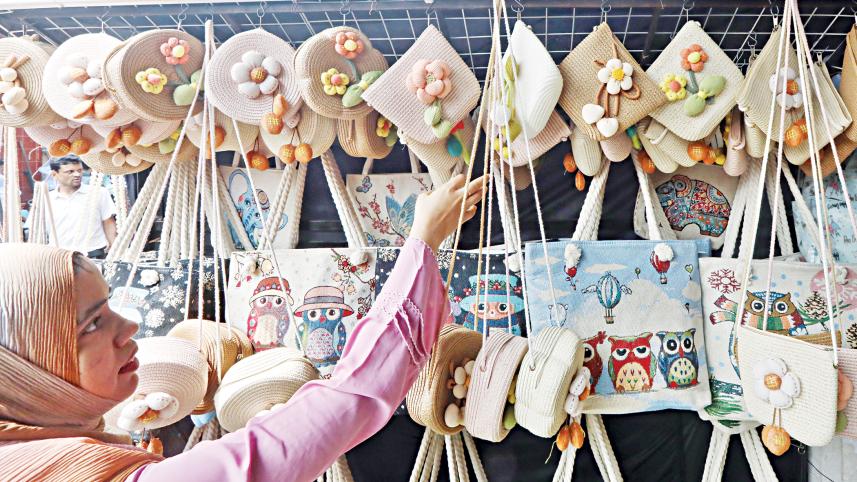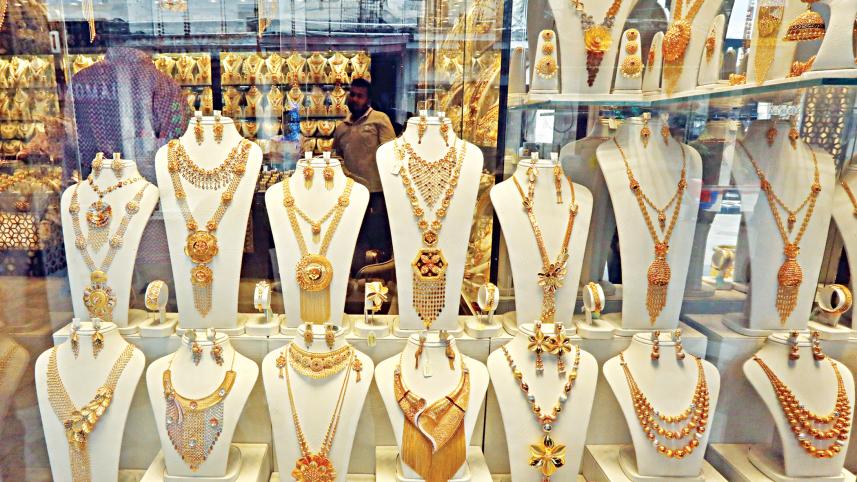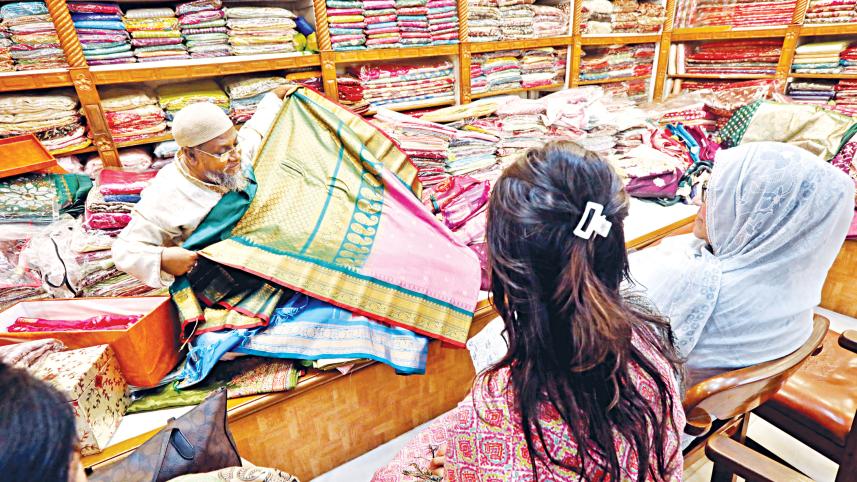73 years on, New Market still a shoppers’ haven. Here’s why

On Friday afternoons, the footpaths outside New Market are nearly impassable. Shoppers carry bags filled with books, clothes, or crockery, while rickshaws inch forward alongside street vendors frying snacks. Inside, narrow lanes are packed with students, families, and office workers all searching for deals, ignoring the crowd, noise, and dust. Haggling between sellers and buyers fills the air.
For some, shopping at the market is a test of patience; for others, it is about memories, trust, tradition, and loyalty. Yet for everyone, New Market remains a place where one can find almost anything and, if they know how, at the best price possible.

Seventy-three years after it was built, the Dhaka New Market remains one of Dhaka's busiest commercial hubs. Despite its chaotic atmosphere and the rise of polished shopping malls like Bashundhara City and Jamuna Future Park, the market continues to attract thousands daily. Fires, waterlogging, traffic gridlock, and occasional clashes between customers and sellers have not diminished its pull. The reasons are straightforward: location, affordability, trust, and a deep sense of tradition that binds generations of Dhakaites to the place.
According to the Dhaka New Market Business Association, the market currently has 444 shops and provides employment to around 3,000 people. Annual transactions are estimated to exceed Tk 500 crore.
For some, like Sakib Mridha, a landlord from Hazaribagh and a former lecturer at the Department of Journalism, Media and Communication at Daffodil International University, the allure lies in both price and reliability.
"I've been coming here for 20 years," Mridha, a regular at the market, said. His usual list includes magazines, garbage bags, utensils, condiments, stationery and other household items.
Even though he now lives in Savar, Sakib often combines errands with a trip to Hazaribagh and the market. "If I didn't need to go there, maybe I wouldn't come as often," he admits. "But if you have specific needs like I do, New Market is the place. If not, local shops or online orders are fine. Still, I find the visits mostly worth it."
"A month ago, I bought a certificate file for Tk 480 here. The same one is sold for Tk 1,200 elsewhere. Garbage bags cost Tk 240 per kilogramme here, Tk 260 in Mirpur or Savar, and the quality isn't the same. Ceylon cinnamon, Tk 1,260 a kg here, Tk 1,600 in Mirpur. And not available in Savar," he added.

His loyalty extends beyond bargains to personal connections. "I go to the same trustworthy shops every time. They would never sell me bad or faulty items. I can't say the same for online shops. I also love the human connections. I've known these people for two decades. We talk, we listen to each other. That matters."
There are downsides too. New Market doesn't offer the most pleasant shopping experience. "It's always crowded, chaotic, everyone shouting, haggling. Professionalism is lacking. The commute is terrible. But still, everything you need is here. Any day, every day."
A large chunk of New Market regulars consists of students from nearby school, college and universities. Located near Dhaka University, Buet, Eden Mohila College, Dhaka College, Dhaka City College among others, it has become an extension of student life.
Hasan Bashir, who studied in the early 2000s, remembers it as a place of freedom where love bloomed. "Back then, there weren't many places where young couples could go without drawing attention. New Market's eateries offered an escape. The people were hospitable, and I still have connections with them."
With a laugh, he added, "My girlfriend from those days is long gone, but I still know the people there. Every visit feels like a trip to that old era, when the crowds weren't so bad and you could spend hours browsing or eating."
For today's students, the reasons are more practical. Everything they need — books, pens, clothes, jewellery, even hostel supplies — can be found at affordable prices. With Dhaka University alone housing nearly 50,000 students, the steady flow of young customers is one reason the market never seems to slow down.
For many of the shop owners at the market, it is a generational business inherited from their ancestors.
For instance, Jibon Shahadat, who runs the Siraj Magazine Centre near Gate No. 1, has carried forward his father's shop since 1999. According to him, it's the loyalty that keeps his business running.
"Digital media has cut demand for storybooks and magazines, but loyal readers keep coming back," he said. "During Durga Puja, one customer ordered every Sharadiya magazine available for his 85-year-old mother. People still value printed material."
Despite economic pressures, the shop nets about Tk 1 lakh a month, reflecting both the challenge and resilience of print media in Dhaka.
Bargaining is a core trait attributed with New Market. The haggling is so intense, that many often brag about the experience and their victory at securing a good deal.
"You need to know how to deal with it," said Sakib. "If you don't know the product and its price, you can get cheated. But that's the same everywhere in the world. I've been to Malaysia, India, Thailand, South Korea — haggling exists everywhere."
For traders, haggling is not just tolerated, it is expected. "Prices are never final," said Abdul Kader, a clothing retailer. "We always leave room for negotiation. If you refuse, the customer feels offended. If you give in too quickly, they think something is wrong with the product."
This culture, combined with the market's accessibility, is a central reason people return.
For many middle-class families, the market is an essential stop during festivals. Parents haggle for clothes, accessories, and gifts, while children wander between bookstores and toy shops. The variety means that everyone, from students to professionals, can find something suited to their budget.

Consistent quality is a deciding factor for drawing in customers. Mohammad Sentu, in business for 25 years, sells car accessories, plastic items, birthday supplies, and stationery. According to him, his customers range from affluent buyers to middle-class families. "Most products come from Chawkbazar and Gulshan, some from China via agents. You have to know your sources and your customers."
At a newly opened Pentel showroom, Rasel Rana spoke about bringing Japanese stationery directly to Dhaka. "Earlier, customers had to source pens and erasers abroad. Now they come here for the same items. Even distant shoppers visit, especially for rare products. Sales have doubled since we opened."
Mohammad Anik Khan, a relatively new ceramic goods retailer at the market, described another side of the market. He offers daily household essentials such as bowls, plates, mugs, and salt shakers, per piece priced at Tk 100, catering to a diverse clientele, including middle-class families, students, and hostel residents.
Despite being relatively new to the market, Anik has observed a positive customer response.
He attributes this to the budget-friendly pricing and the good quality of the items, which often leads to customers making repeat purchases.
Even jewellery finds its market here. Mohammad Al Amin, manager of New Milon & Hashem Jewellers, has served for 12 years. "Most customers are repeat buyers because of honesty and quality," he said. "A grandmother once shopped here, now her grandson is also a customer. Gold prices have made business harder, sales dropped by around 50 percent. But people trust us, and that keeps them coming."
Sarees are one of the most popular items. Mohammad Khaled Mamun, owner of Jesimun Sarees, "We stock Katan, Tangail, and Jamdani sarees. Prices range from Tk 800 to Tk 15,000. People know they can find reasonable prices here, unlike malls where everything is expensive."
Imitation jewellery also thrives. Rabbi Hossain, manager of a shop selling antique-style pieces, said: "Students, homemakers, professionals — they come for design, quality, and trust. Daily sales average Tk 20,000–Tk 25,000. We opened a second outlet because customers kept coming."
FROM ELITE BEGINNINGS
TO A MARKET FOR ALL
When New Market first opened in 1952 and completed in 1954, it was meant to serve Dhaka's elite. Its futuristic triangular shape, 35 acres of land, and 440 shops made it a modern alternative to Old Dhaka's alleys. At the time, only 25-30 shops opened, leaving ample space to browse. Imported goods, luxury items, and clothing were the primary offerings.
Over time, the market evolved. By the 1980s, it had become a hub for middle-class families seeking household essentials. Today, it serves everyone ranging from students, business owners, working middle-class residents, to occasional affluent visitors. Its location near universities, offices, and healthcare centers ensures constant footfall. Surrounding markets such as Gausia, Globe, Chandrima, Noorjahan, and Nilkhet Book Market have turned the area into a comprehensive shopping hub offering nearly everything at affordable prices.
Even as Dhaka is filled with malls and online shopping platforms, New Market offers flexibility. Customers can buy a single spoon or a whole dinner set, a secondhand book or the latest fashion item. They can spend hours browsing or pick up what they need in minutes. Students, homemakers, and small business owners all find something suited to their needs.
For Dhaka's residents, New Market is more than a shopping complex. It is a place where traditions continue, where students grow into professionals but still return, and where generations of families have bought everything from school uniforms to wedding sarees. It is noisy, chaotic, and sometimes overwhelming. But after 73 years, its popularity shows no signs of fading.






 For all latest news, follow The Daily Star's Google News channel.
For all latest news, follow The Daily Star's Google News channel.
Comments